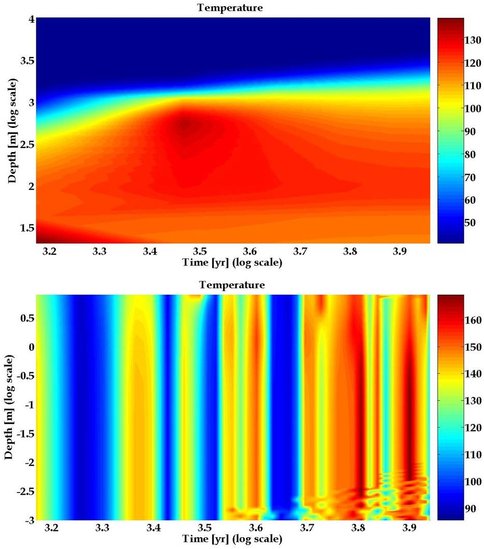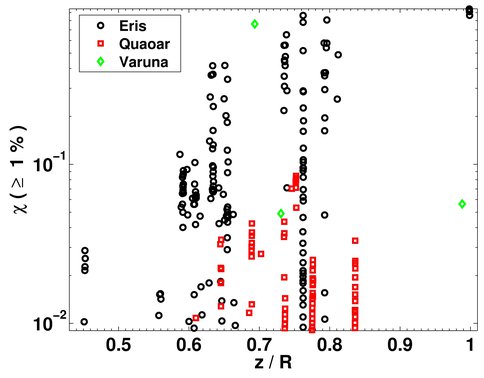2011 Annual Science Report
 University of Hawaii, Manoa
Reporting | SEP 2010 – AUG 2011
University of Hawaii, Manoa
Reporting | SEP 2010 – AUG 2011
Solar System Icy Body Thermal Modeling and Evolutionary Pathways
Project Summary
Thermal processing on small icy bodies in the solar system (comets, asteroids, Kuiper belt objects) will cause the volatile composition and interior structure to change over time. We seek to understand the evolutionary processes in these bodies so we can understand the observations made in the present epoch and to what extent we can infer the earliest stages of the solar system from these objects.
Project Progress
“Early Thermal Evolution of Planetesimals Beyond the Snow Line”
We completed simulations of the early evolution of icy planetesimals, before they are incorporated into giant planets or ejected from the planetary system. The volatile composition and interior structure of these objects change considerably prior to interaction with the giant planets, due to intrinsic thermal evolution of the different planetesimals. Some volatiles may survive throughout (until incorporated in planetary atmospheres or ejected further outside), but the varied thermal histories may impose an additional composition gradient to that inherent from the disk’s physical-chemical evolution.
The early thermal and structural processes that affect planetesimals have strong implications for planet formation scenarios and the attributes of large dusty aggregates in proto-planetary disks. The record for the evolution of these “building blocks” may be interwoven in the profiles of nowadays cometary bodies of various sizes, compositions, and presumed source regions. Representative examples of the meter-scale and km-scale populations have been modeled, with varying orbits and compositions. Emphasis is put on the emerging structure, heat input history, amorphous-to-crystalline water ice transition, and possible volatile retention.
Objects were modeled as cometary-like and we take into account internal evolution driven by various heat sources, the most important being, crystallization and radioactive decay (of either short-lived radionuclides or long-lived ones). In terms of composition, we include a composition of refractory silicate-mineral solid grains and a mixture of volatiles, either in solid (ice) or gaseous (trapped) state. Here we restrict our simulations to consider only CO2, CO and HCN as representatives of the volatile species, other than water, as they are the most common in planetary environments and are among the most abundant cometary volatiles observed. The early presence of organic compounds in the interiors of planetesimals can affect the heat balance and phase transitions of water.
We set several distinctions in our models, to account for some of the breadth of possible configurations: (i) Orbit – Heliocentric distance near the Jupiter-Saturn center of mass (“J-S zone”) and near the Saturn-Uranus center of mass (“S-U zone”), with varying eccentricities; (ii) Size – Radii of 10 m to 100 km, where a hydrostatic scheme is implemented for the larger objects, affecting porosity and thermal conductivity; (iii) Thermal input – Solar radiation alone and combination with radioactive heating, where only the larger objects can be effectively heated by radionuclides; (iv) Time span – 10 Kyr for bodies heated by solar radiation alone and ~100 Kyr for those heated by radionuclides as well. These timescales are on the order (or less) of the dynamical lifetime of planetesimals in these regions.
All of the above calculations have been completed. We are now in the process of combining more volatile organic species into the model. We will calculate the evolution of planetesimals as a function of their direct dynamical evolution, under different chemical conditions in the protoplanetary disk, through a collaboration with Jade Bond (UNSW), Sean Raymonds (Bordeaux) and David O’Brien (PSI). These collaborators have already done simulations of dynamical states of terrestrial-forming planetesimals, under different disk chemistry conditions. A paper is in the final stages of completion, and the material was presented at the 2011 EPSC-DPS meeting.
“Retention of Water and Organic Compounds in Kuiper Belt Objects”
Observations have revealed that many large (>~1000 km in diameter) Kuiper belt objects (KBOs) exhibit features of crystalline water ice in their surface spectra. Some may even exhibit amorphous ice features. In addition, some of these objects show distinct spectral features of volatile ices, such as Methane and Ethane and even Ammonia. The presence of such features of organic ices could be explained as a consequence of atmospheric escape of these compounds. The crystalline ice features on the surface suggest a thermal processing history, which would increase the rate of volatile lose. An interesting question is how to get mixed reservoirs of water and volatile organic ices close to the surface, so it can be either observed directly, or be subjected to a thermal escape mechanism.
We model such KBOs as icy, cometary-like, bodies. Modeling the internal evolution of such bodies takes into account various heat sources, the most important being, crystallization and radioactive decay (of either short-lived radionuclides or long-lived ones). In terms of composition, these models deal with a composition of refractory silicate-mineral solid grains and a mixture of volatiles, either in solid or gaseous state. Here we restrict our simulations to consider only CH4, NH3 and CO2, as representatives of the volatile species, other than water. We combine in our models the thermal processing of ices, due to radioactive heating, insolation (may be negligible for surface compositions in the outer Solar System and Trans Neptunian region) and crystallization of amorphous water ice (as a triggered source of internal energy), and the treatment of gad flow and densification of a varying porous medium. The presence of organic compounds inside KBOs affects the internal heat balance and phase transitions of water. This is examined self-consistently, as the abundances and locations of these compounds evolve.
We have shown that under certain conditions, layers of crystalline water ice, amorphous water ice and CH4 or NH3 ice can co-exist. In some cases it is possible to reach thermodynamic states that favor the melting of water ice and retention of the liquid phase. The intermittent layers of ices, which are a part of an overall semi-stratified internal structure, can be found at a depth of 1-5% of the object’s radius. This depth is slightly higher than the roughness scale found for Ceres, a dwarf planet, which resembles large KBOs, but is a Main Belt Asteroid. However, we should note that KBOs probably contain more ices than MBAs, implying lower densities and corresponding higher porosities, at layers near the surface. The above mentioned consideration could mean that deep depression features may easily arise on surfaces of KBOs (either as primordial topography or as impact cratering), exposing water and volatile ice spectral signatures.
We are still in the process of combining different hydrate components (ammonia, methanol and a mix), that can lower the melting temperature and introduce different eutectic stages. This is crucially needed in order to examine the actual extent of cryovolcanism in a porous matrix and has not yet been considered by any existing model for icy body evolution. A paper is in the process of revision (submitted to Icarus), and a second has been revised.
Internal Temperature profiles for a 10 km (top) and 10 m (bottom) object in the J-S zone with high eccentricity and no radioactive heating. Both planetesimals are from the J-S zone and have high eccentricities, so that they venture within the snow line. The 10 km object has a “bump” at ~30 Kyr, due to rapid onset of a crystallization front. However, from that point on, the temperature gradient changes and the interior below a few km is pristine. The 10 m object exhibits the effect the heat diffusing throughout the whole body, sublimating most of the ice at very early times. This is due to the fact that the orbital thermal skin depth is of the order of the size of the object.
Snapshot of internal structure at the end of a long-term simulation run for Kuiper Belt object (136472) Makemake. Stratified ice structure is show as mass fraction of ices vs. relative depth, below the surface (z/R=0). We focused here on the region around the maximum abundance of me-thane ice.
Level of saturation (volume occupied by liquid water per void volume inside pores) as a function of relative depth. Shown here are Kuiper belt objects (136199) Eris (black circles), (500000) Quaoar (red squares) and (20000) Varuna (green diamonds). Below the level of ~1% in our model, saturation is practically negligible.
-
PROJECT INVESTIGATORS:
-
PROJECT MEMBERS:
Gal Sarid
Project Investigator
Dina Prialnik
Co-Investigator
Jade Bond
Collaborator
Steven Desch
Collaborator
David O'Brien
Collaborator
Sean Raymond
Collaborator
-
RELATED OBJECTIVES:
Objective 1.1
Formation and evolution of habitable planets.
Objective 2.2
Outer Solar System exploration
Objective 3.1
Sources of prebiotic materials and catalysts


